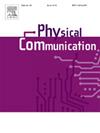Cognitive semantic communications with codebook-based adaptive correction for image classification
IF 2.2
4区 计算机科学
Q3 ENGINEERING, ELECTRICAL & ELECTRONIC
引用次数: 0
Abstract
Conventional bit-oriented communication paradigms face several critical challenges in emerging sixth-generation (6G) wireless scenarios. One of the key challenges is low-efficient symbol transmission without considering task-oriented semantic importance, thus leading to high bandwidth consumption. To overcome this challenge, we propose a novel cognitive semantic communication (CSC) framework for the image classification, where the remote facial expression recognition for drivers is considered. Unlike conventional semantic communication methods that passively handle predefined semantic features, the proposed CSC framework actively identifies and adapts the most critical emotional features for transmission, substantially reducing bandwidth and signal quality requirements while preserving essential expression details. Moreover, for the first time, we design a cognitive-inspired semantic inference model equipped with a codebook-based correction mechanism to mitigate semantic distortion caused by physical channel impairments, enhancing reliability and interpretability under adverse conditions. Extensive simulation results demonstrate that proposed CSC can significantly outperform existing methods in recognition accuracy under constrained communication scenarios. By integrating cognitive-inspired semantic extraction, intelligent encoding–decoding processes, and context-aware inference, our proposed approach advances the state of the art in semantic communications for the image classification, offering a more robust and resource-efficient solution.
基于码本自适应校正的认知语义通信图像分类
在新兴的第六代(6G)无线场景中,传统的面向比特的通信范式面临着几个关键挑战。其中一个主要的挑战是没有考虑面向任务的语义重要性的低效率符号传输,从而导致高带宽消耗。为了克服这一挑战,我们提出了一种新的认知语义通信(CSC)框架用于图像分类,其中考虑了驾驶员的远程面部表情识别。与被动处理预定义语义特征的传统语义通信方法不同,所提出的CSC框架主动识别并适应传输中最关键的情感特征,在保留基本表达细节的同时大大降低了带宽和信号质量要求。此外,我们首次设计了一个认知启发的语义推理模型,该模型配备了基于码本的纠错机制,以减轻物理信道损伤引起的语义失真,提高了不利条件下的可靠性和可解释性。大量的仿真结果表明,在受限通信场景下,该算法在识别精度上明显优于现有方法。通过整合认知启发的语义提取、智能编码-解码过程和上下文感知推理,我们提出的方法推进了图像分类语义通信的最新进展,提供了一个更鲁棒和资源高效的解决方案。
本文章由计算机程序翻译,如有差异,请以英文原文为准。
求助全文
约1分钟内获得全文
求助全文
来源期刊

Physical Communication
ENGINEERING, ELECTRICAL & ELECTRONICTELECO-TELECOMMUNICATIONS
CiteScore
5.00
自引率
9.10%
发文量
212
审稿时长
55 days
期刊介绍:
PHYCOM: Physical Communication is an international and archival journal providing complete coverage of all topics of interest to those involved in all aspects of physical layer communications. Theoretical research contributions presenting new techniques, concepts or analyses, applied contributions reporting on experiences and experiments, and tutorials are published.
Topics of interest include but are not limited to:
Physical layer issues of Wireless Local Area Networks, WiMAX, Wireless Mesh Networks, Sensor and Ad Hoc Networks, PCS Systems; Radio access protocols and algorithms for the physical layer; Spread Spectrum Communications; Channel Modeling; Detection and Estimation; Modulation and Coding; Multiplexing and Carrier Techniques; Broadband Wireless Communications; Wireless Personal Communications; Multi-user Detection; Signal Separation and Interference rejection: Multimedia Communications over Wireless; DSP Applications to Wireless Systems; Experimental and Prototype Results; Multiple Access Techniques; Space-time Processing; Synchronization Techniques; Error Control Techniques; Cryptography; Software Radios; Tracking; Resource Allocation and Inference Management; Multi-rate and Multi-carrier Communications; Cross layer Design and Optimization; Propagation and Channel Characterization; OFDM Systems; MIMO Systems; Ultra-Wideband Communications; Cognitive Radio System Architectures; Platforms and Hardware Implementations for the Support of Cognitive, Radio Systems; Cognitive Radio Resource Management and Dynamic Spectrum Sharing.
 求助内容:
求助内容: 应助结果提醒方式:
应助结果提醒方式:


